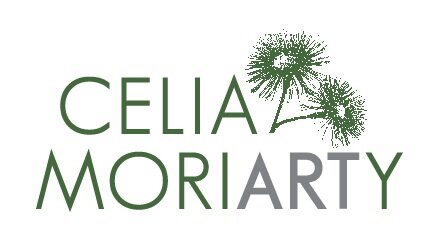Do you know which Australian Artist won Gold medals in Melbourne, London, St Petersburg, Amsterdam, Calcutta, Denmark and Chicago?
No? You are not alone.
The most celebrated Australian artist who was once a household name is not mentioned in today’s version of Australian art history.
Ellis Rowan – The Flower Hunter 1848- 1922
Ellis Rowan was consistently recognised for over 50 years as one of the best artists of any genre in international exhibitions and competitions - she was not seen by the international stage as a mere flower painter.
I was familiar with some of her gentle botanical water colours but thought her a botanical artist who was a great adventurer. However, as you look at her work particularly the New Guinea oil paintings that show the flower boldly bursting from the page, I saw my own work and what I am trying to achieve 100 years later – thinking it was new. She worked as an impressionist producing a vast volume of work and was often compared to the new technology of photographs.
It is surprising that Heidi Museum did not include her in the recent exhibition with Georgia O’Keefe as Georgia's work is so like Ellis's. Ellis travelled extensively in USA for twelve years documenting flora and illustrated three books of botanical texts that Georgia may well have seen.
I am going to list some of her accomplishments here, just so you can see how extraordinary her achievements were as she travelled in outback Australia for months on end and through so many countries , deserts and jungles alike to capture her subjects on paper and canvas – in a corset, immaculately dressed with praise and respect (except from the male artists) from those around her.
Ferdinand Von Mueller the appointed Victorian Government Botanist and Director of the Royal Melbourne Botanic Gardens used the young Ellis Rowans paintings to identify unknown species, but her work was to gain international acclaim far beyond botany.
When the Melbourne Exhibition buildings opened in 1880, with exhibits from 30 countries, she took gold and silver. To give you some context The Victorian Artists Society was outraged and protested to the international jury who later conceded a silver medal to Louis Beuvelot. By 1900 Ellis Rowan was so well known in Australia that she was apparently a household name.
1883 Gold medals were awarded to Ellis Rowan in Calcutta, St Petersburg, Amsterdam and Denmark the following year.
1888 Ellis scooped the Centennial Art Exhibition Prizes. Held at the Melbourne Exhibition Buildings and said to be the grandest ever held, it included every country in the British Empire as well as Europe, America and Japan. A second silver award was given to Tom Roberts and third prize to Fred Mc Cubbin. The male artists and Victorian Artists Society were again furious and called a meeting to contest the judgement. You will be pleased to know that they were ridiculed for it by the international jurors. Norman Lindsay was another male artist who ridiculed her work calling it "vulgar" as she was being sought and acclaimed internationally in a way these men could only dream of.
1889 Adelaide Jubilee Exhibition she one five firsts and Gold.
Here in her hometown Ellis was invited to paint 12 large panels for the Australian Club – a men only domain and other such hallowed turf as the Victorian Racing Clubs govenor’s dining room.
1893 World Columbian Exhibition in Chicago – entered 99 paintings and took Gold.
Queen Victoria collected three of Ellis Rowan’s paintings as well as other royal family members. Lord Leighton, ex President of the Royal Academy attended her solo London exhibition in 1896 was also her fan. With these two in her court London was enchanted by her Australian Wildflower paintings and Australia was in the news for something other than Ned Kelly..
Around this time the German Chancellor offered to purchase Ellis’s collection for 15,000 pounds and invited her to remain in Germany as it’s botanical artist. - she refused apparently on patriotic grounds. Ellis then set off to America and the West Indies and collaborated on 3 books that became standard botany texts.
1901 Clausen’s Fifth Avenue Gallery showed 500 of her paintings of American wildflower paintings.
Kalgoorlie next, where her show of local flora was praised only to find that in Perth she was criticised as not local.
1916 at 68 Ellis set off to New Guinea and painted the flora and birds. She lived in primitive conditions, bribing the locals to bring her birds. They had to be caught to paint them.
“The large ones I tucked under my arm and held in that way while I painted them. Some were fierce and hard to hold… I covered the heads of others with handkerchiefs or table napkins to keep them a little quieter while painting the body.” I so often work from photos - so cushy!
Although the SA Gallery purchased 80 works, The National Gallery of Victoria holds 5, The QLD government bought 100 (Rowan gave them a gift of an extra 25) the purchase of her collection was debated in Parliament with Billie Hughes PM as her advocate, but the purchase was not made before her death in 1922.
I have been using her work to help me create depth in my paintings but did not realise that she had been feted as one of the great artists of the world for 50 years. Shame on the art schools of today that miss the opportunity to show such an individual spirit, passionate adventurer, prolific documenter of nature and astoundingly creative talent.
Reference
2002, The Flower Hunter – Ellis Rowan , Patricia Fuller Published by the National Library of Australia
2009, Women of Flowers - Botanical Art in Australia from the 1830s to the 1960s, Leonie Norton Published by the National Library of Australia



